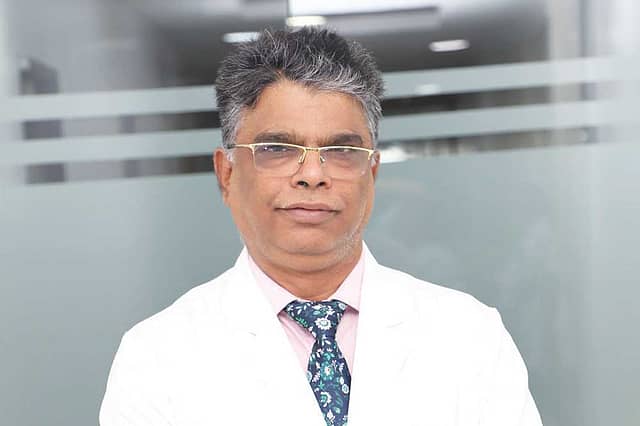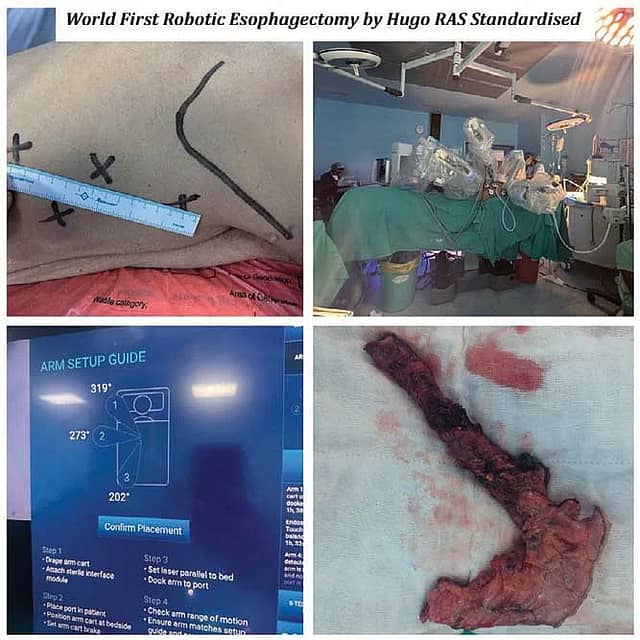Robotic Surgery is the Future In Cancer Surgery

Could you elaborate on your expertise which lies in minimal invasive Surgical Oncology and Robotic Onco-surgery?
Surgical oncology in layman's word is cancer surgery done for different organs. But with medical advancements, the specialization has become site specific, meaning, now there are surgeons having expertise in organ specific surgery such as breast, gynae, head and neck, lung, GI and Thoracic. Today, we are in the era of minimally invasive surgery, which is a keyhole surgery using laparoscopy technique by making small incisions. In robotic oncosurgery, the only difference as compared to laparoscopy is that the surgical instruments are attached to the wrist of the robot, which has a 360 degree dexterity enabling magnified 3D visibility of the affected site, including deep seated malignancies in any part of the body such as below the diaphragm and in the thorax for oesophageal surgery. The robot is remotely manoeuvred by the surgeon, who sits at the console giving instructions which the robot follows while performing the surgery. But there is a surgeon present in the operation theatre with the patient, to supervise how the arms of the robot is working and to handle assistant port. The presence of the doctor also serves as a back-up and rules out chances of any lapses in the event of any unprecedented situation, giving confidence to the patient.
What are the advantages of minimally invasive or robotic surgical oncology?
The result of the key-hole and robotic surgeries is that they are high on precision, less painful, blood loss is negligible, minimal scarring, chances of infection is reduced drastically and recovery is fast leading to a normal life. Consequently, it lessens the financial burden on the patient as days of hospitalization is reduced to 5 days or so as compared to two weeks stay in open surgery, were the incisions are wide and deep, which lengthens the hospitalization of the patient, the recovery is slow and the surgery is more vulnerable to infections. It also delays the chemo sittings whereas it can be commenced within 3 three weeks of recovery if operated by a robot. Robotic oncosurgery is gaining acceptance and popularity for its versatility and high success rate.
Among the areas of your specialization, which of the cancers have a wider penetration in the population and why?
There are many kinds of cancers, but the most prevalent, which leads amongst all cancers is the breast cancer followed by the cervix, lung, head and neck. But robotic surgery is mostly done for organs located in the abdomen, which in medical parlance is known as GI Onco surgery, cancer of the kidney or uterine cancer. Particularly, in GI surgery, oesophagus is a very complex area to operate, which is inside the thorax or chest and it's best operated with a robot for the 3D magnified vision that it provides a clear view of the site. Similarly, in colorectal surgery, robots can go to very low level with Sphincter preservation.
What are the different minimally invasive surgery methodologies generally used in cancer treatment and chances of cure?
Mostly minimally invasive surgeries like laparoscopic surgical oncology is performed for cancers of the colon, rectum, kidney, uterus, stomach and oesophagus. In stage one of cancer the chances of cure are 95 to 98 percent, at stage two it is around 90 percent and when the tumour spreads to stage three it is reduced almost to 60-65 percent. In stage four, the cure mostly depends on the chemo therapy to control the spread, but chances of cure is reduced drastically, and we do not operate at this advanced stage and mostly disease control.

At what stage of cancer would you recommend robotic or key-hole surgery to the patients?
There is no compulsion that the patient has to opt for robotic surgery, and we do let them make the choice, or whichever methodology that best suits the condition and affordability is considered. We recommend robotic surgery preferably in the early stage (one and two) of cancer. In stage three of cancer, the patients are first given chemo and then operated depending upon the evaluation of the CT scan and Tumor Board Decision. Mostly oesophagus, rectum, prostate, kidney tumours, which are old can be operated using robotic. Chemo and radiation therapies are generally used after the onco surgery to kill any existing tumour cells to clear the site of cancer.
Which is the most advanced robot used in cancer surgery and the models used currently in India?
The most preferred is the Da Vinci Robot from the US and the second most popular is Hugo RAS, which we have in our department at Paras Hospital followed by CMR from the UK, and the fourth one is the indigenous SSI Mantra, a Make in India robot, as good as rest of the imported robots. The Indian robot is being procured and used extensively by many hospitals as it gives the same results.
Hugo RAS is a very stable robot having a large and wide 3D screen, so the surgeon can directly communicate with the surgeon without having to leave the console and go to the OT for giving any instruction, but is not the case with Da Vinci robot as it is a closed one.
Also, whenever a surgeon is shifting from laparoscopic to robotic, the Hugo RAS, which is one of the good robots same type of key holes are made similar to laparoscopic with four separate arms, which can be used in any direction and is of advantage, whereas, the Da Vinci robot has four hands in a row that restricts mobility unlike the Hugo RAS.
What is your opinion about the role of hi-tech technology in healthcare?
AI enabled Technology is a game changer in the medical field and is here to stay. The Google Halo Lens has made its advent where you can instruct and train the assistant how to do the surgery from any remote distance, which is very handy.
The next breakthrough that would boost surgery capabilities is image integration. For this CD with images of the CT scan of the tumour is inserted in the robot, which reads the CD and goes to the exact site of the tumour and does the surgery as per instructions provided by the surgeon. However, it's a next generation technology having AI and is expected to be in use probably in the next five years.

That 5G would revolutionize the surgical field enabling operations to be done remotely on patients across continents, trials have been carried out by a company, but it's a possibility in the near future. In all upcoming AI based technologies in surgery, training of doctors would be absolutely essential to be comfortable with the new operating system and must be guided by a senior surgeon on daily basis.
New molecular drugs are being developed to kill cancer cells and with the help of Hi-tech technology. On the surgical front the robots, key hole surgery and newer types of imaging integrated programmes, will be future.
(A marketing initiative by Open Avenues)